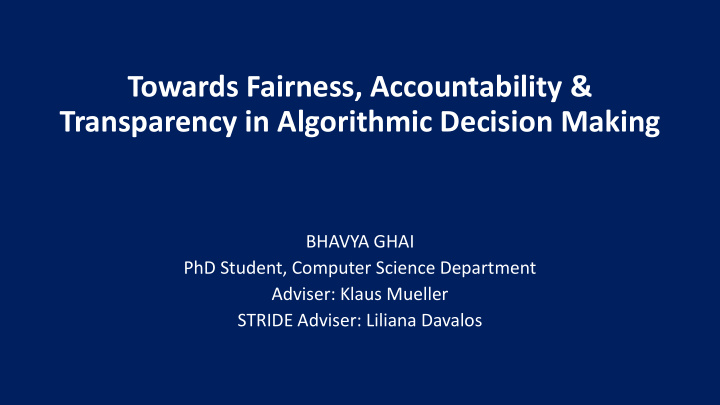



Towards Fairness, Accountability & Transparency in Algorithmic Decision Making BHAVYA GHAI PhD Student, Computer Science Department Adviser: Klaus Mueller STRIDE Adviser: Liliana Davalos
https://www.propublica.org/article/machine-bias-risk-assessments-in-criminal-sentencing
How Algorithmic Bias is impacting Society? Allocative Harms Representation Harms Recidivism Algorithms are trying to replicate the bias encoded in data
In the media …
Existing work Interpretation Data Model Data Stage Fairness through unawareness Sampling/Re-weighting Modifying output variable Non-interpretable transformations Model Phase Add constraints to loss function Regularization Synthetic Admissions data Dealing with Bias at the Data stage provides most flexibility
Evaluation Utility Fairness Accuracy F1 score AUC Group Individual Fairness Fairness TPR IFM FPR Distortion (k-NN) SSE GDM MSE MAPE SMAPE Preserve utility, maximize fairness & minimize distortion
Gaps in Literature Accountability Fairness Transparency Trust Domain Knowledge We can’t rely on existing Techniques to take life changing decisions
Our approach – Human Centered AI Fast Domain Expertise Economical Interpretable Unbiased Storytelling Opaque Expensive Non-culpable Biased No domain Knowledge Slow Algorithm Human Propose an interactive visual interface to identify and tackle bias Understand underlying structures in data using interpretable model like causal inference Infuse domain knowledge into the system by modifying causal network Evaluate debiased data using Utility, Distortion, Individual fairness & group fairness Our approach brings the bests of both worlds!
Computational Components Causal Network CGPA International TOEFL Admitted GRE Verbal Debiasing W 2 W 1 y new = y – w 1 x z x y z new = z – w 1 w 2 x Causal Networks are interpretable and enable data-driven Storytelling
Computational Components cont. Dimensionality Reduction MDS/PCA/TSNE Evaluation Metrics Individual Group Utility Distortion Bias Bias Mean accuracy of Mean number of GDM = Symmetric mean an ensemble of ML neighbors with |FPR max -FPR min | absolute percentage models same label + error (k-NN) |FNR max - FNR min | (SMAPE) Visual inspection along with evaluation metrics infuses more trust
Proposed Architecture Human Supervision Causal Network Visualization Evaluation metrics Debiased Raw data data Debias Semantic Suggestions Humans can infuse domain knowledge by interacting with the causal network
Our Contribution Fairness Transparency Accountability Using multiple fairness definitions Interactive visual interface boosts transparency Human in-charge can be held accountable Data-driven Storytelling Multidisciplinary Trust Human expert infuses domain knowledge into system Investigate policies by traversing causal network Human brings more trust into the system Introducing Human in the loop is the way forward!
Current state Basic framework along with causal network is implemented
Future Work Work on different components of the visual interface Improve graph layout algorithm to reduce number of intersections Current Proposed Algorithmic Bias Improve semantic suggestions by combining with correlation Social Computational Select optimal hyperparameters to calculate utility Science Science Communication Computer Studies Test our framework on broad set of use cases. Law Science Linguistics (IACS collaboration can be very useful here) Maths Psychology If we get an extension, We will tackle Representation bias & stereotypes IACS collaboration can give this project new wings!!!
Conclusion Algorithmic Bias is the real AI danger which can have broad social implications Existing black box models can’t be used for life changing decisions Proposed a novel human centric approach which brings best of both worlds Our approach enables humans to monitor, intervene and override if required In future, we will test our framework on different use cases & tackle representation bias Don’t trust algorithms blindly. They can only be as neutral as the training data & the people developing them. Image: https://www.dreamstime.com/royalty-free-stock-images-finish-line-image29185929
Thank You … Image: https://depositphotos.com/99431064/stock-photo-man-hand-writing-any-questions.html
References Biased algorithms are everywhere & no one seems to care AI programs exhibit racial and gender biases, research reveals When Algorithms Discriminate AI is hurting people of color and the poor. Experts want to fix that How to Fix Silicon Valley’s Sexist Algorithms Houston teachers sue over controversial teacher evaluation method
Algorithms vs Humans * Algorithms are often implemented without any appeals method in place (due to the misconception that algorithms are objective, accurate, and won’t make mistakes) * Algorithms are often used at a much larger scale than human decision makers, in many cases, replicating an identical bias at scale (part of the appeal of algorithms is how cheap they are to use) * Users of algorithms may not understand probabilities or confidence intervals (even if these are provided), and may not feel comfortable overriding the algorithm in practice (even if this is technically an option) * Instead of just focusing on the least-terrible existing option, it is more valuable to ask how we can create better, less biased decision-making tools by leveraging the strengths of humans and machines working together http://www.fast.ai/2018/08/07/hbr-bias-algorithms/
Long term solution Who code matters? -- Have diverse teams to cover each others blind spots How we code matters? -- Don’t just optimize for accuracy, factor in fairness Why we code matters? -- End objective shouldn’t just be profits. Unlock greater equality if social change a priority
Problem Statement How can we make Algorithmic Decision Making more fair, transparent &
Agenda Algorithmic Bias Motivation Existing Work Our Approach Demo Future Work
Algorithmic Bias Fast Domain Expertise Economical Interpretable Unbiased Biased Expensive Opaque Biased Non-culpable Slow Algorithm Human Algorithms are not intrinsically biased but we are. Type of Bias : Gender, Race, Age, Personality, etc. Sources of Bias : Training data, Developers “Algorithms are opinions expressed in code” – Cathy O’Neil
Partial Debiasing More Fairness causes more data distortion
Future Work Improve graph layout algorithm to reduce number of intersections Current Proposed Current Proposed Algorithmic Bias Social Computational Science Search for better hyperparameters to evaluate utility. Science Communication Studies Computer Law Science Test our framework on broad set of use cases. Linguistics Maths Psychology (IACS collaboration can be very useful here) If we get an extension, We will tackle Representation bias & stereotypes IACS collaboration can give this project new wings!!!
Recommend
More recommend